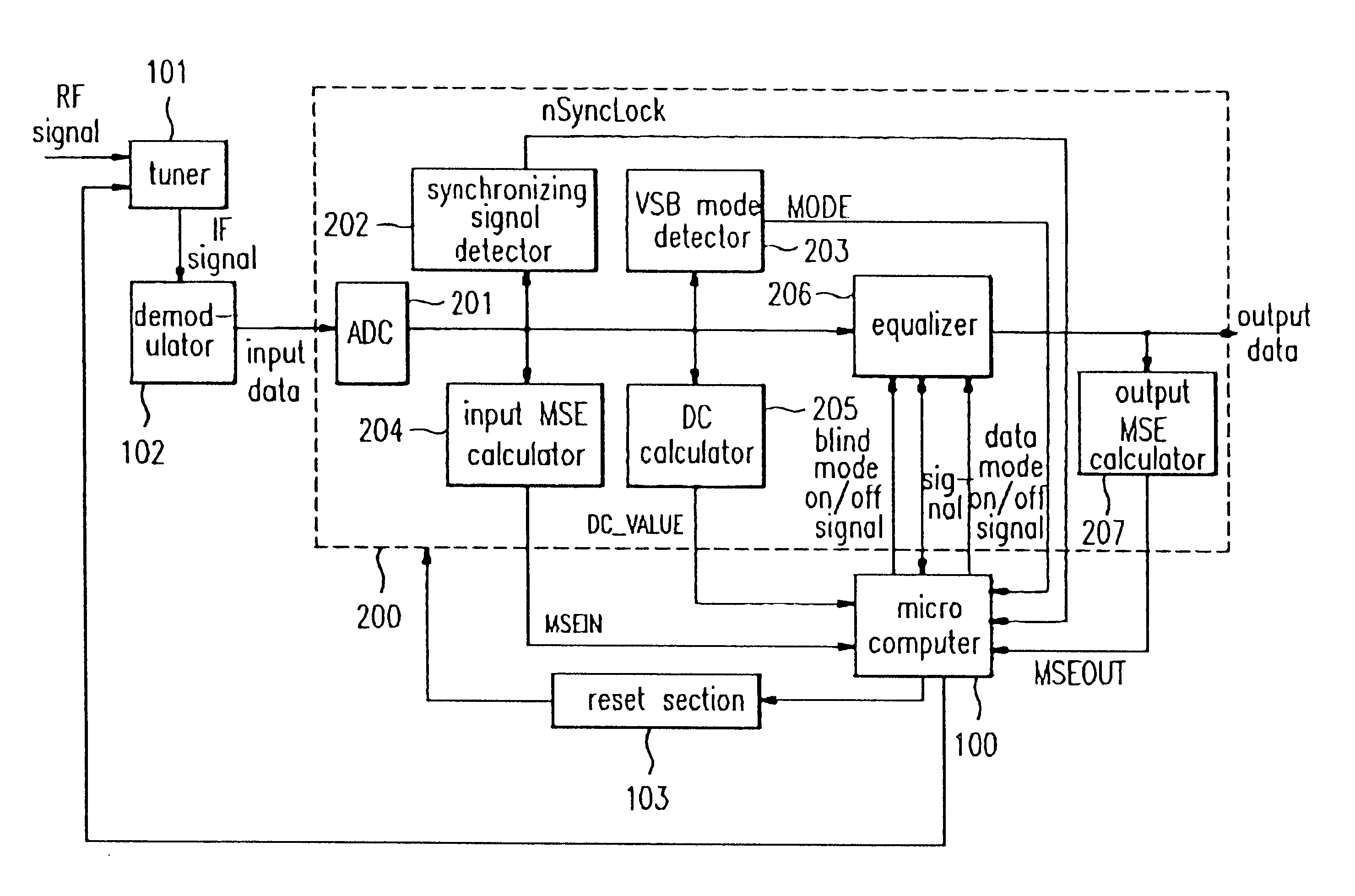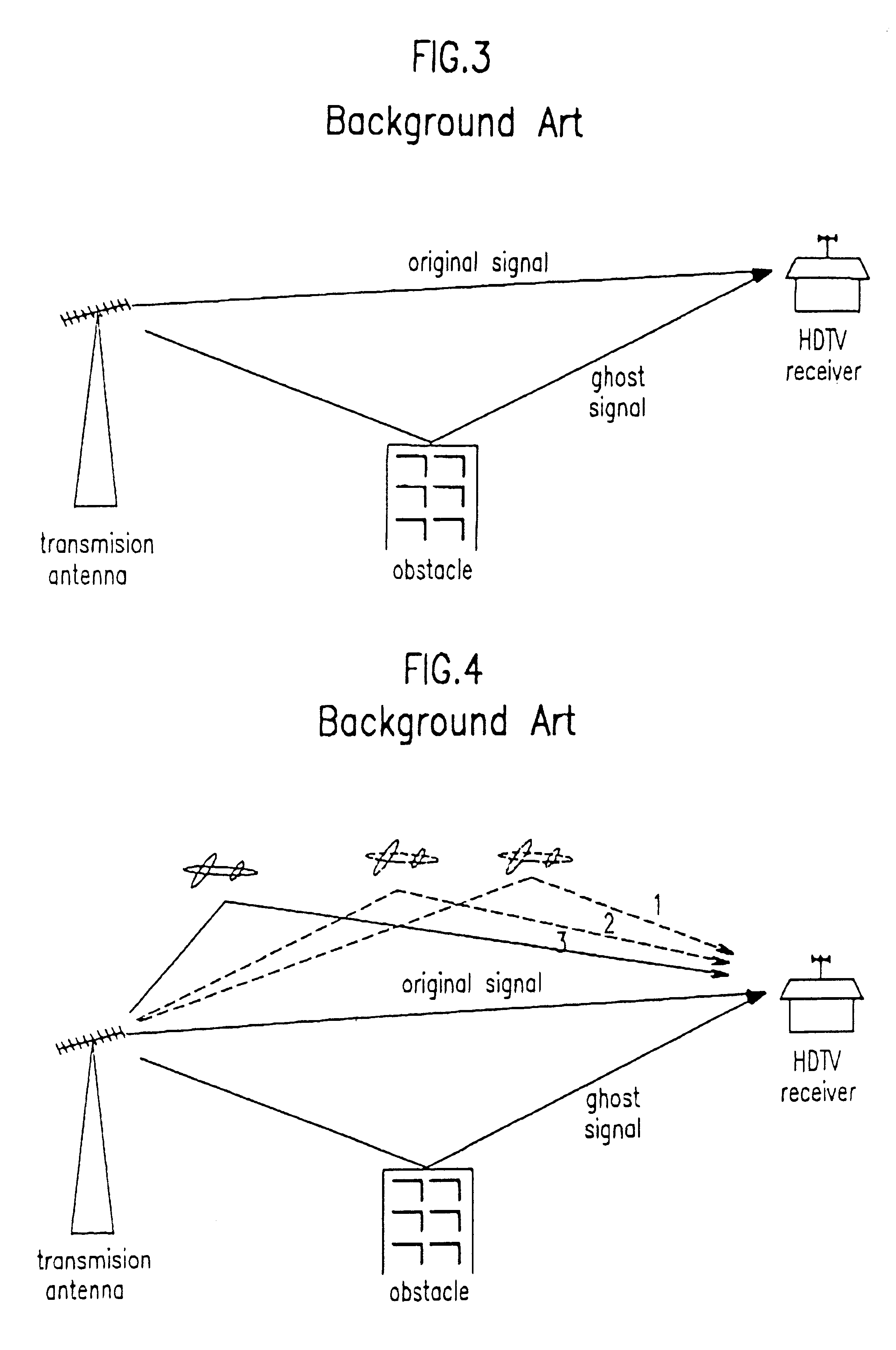Method and apparatus which compensates for channel distortion
a channel distortion and channel compensation technology, applied in the field of digital tv systems, can solve the problems of system performance degradation, insufficient training sequence, and insufficient training sequence to remove moving ghosts
- Summary
- Abstract
- Description
- Claims
- Application Information
AI Technical Summary
Problems solved by technology
Method used
Image
Examples
first embodiment
Upon the completion of initialization, the microcomputer 100 judges if the signal nSyncLock output from the synchronizing signal detector 202 is `0` (step 502). When it corresponds to `0`, meaning that both the data segment synchronizing signal and field synchronizing signal are detected, the process goes to step 504 for checking if the moving ghost exists. When the signal nSyncLock is `1`, meaning that the synchronizing signals are not detected, the channel decoder 200 and the tuner 101 of FIG. 5 are reset, to restart the process from the beginning (Step 503). Similar to the first embodiment, this operation is performed on assumption that a signal nSyncLock of `0` is generated when the synchronizing signal detector 202 detects both the data segment synchronizing signal and field synchronizing signal, and a signal nSyncLock of `1` is generated otherwise.
When the signal nSyncLock is judged to be `0` in step 502, the DC calculator 205 calculates the DC value loaded in the 10-bit digit...
third embodiment
FIGS. 12A and 12B show the present invention. Only portions of FIG. 12A, which are different from FIG. 11A, will be described below. Referring to FIGS. 11A and 11B, the process goes to the step of judging if the moving ghost exists when the value of the counter_1 which indicates how many times the microcomputer 100 reads the DC value from DC calculator 205 does not correspond to `10`. In FIG. 12A, however, the process returns to step 604 to repeat the operation of reading the DC value until the value of the counter_1 becomes `10` when the microcomputer 100 did not read the DC value ten times, i.e. when Counter_1.noteq.10. According to an experimental result obtained by realizing the algorithm of FIGS. 11A, 11B, 12A and 12B, the performance of the system by the process of FIGS. 11A and 11B is similar to that by the operation of FIGS. 12A and 12B.
fourth embodiment
FIGS. 13A and 13B show the present invention. Only portions of FIGS. 13A and 13B, which are different from FIGS. 11A and 11B, will be described below. There may be various methods for storing values in the memory[20]-memory[1]. In FIG. 11A, the minimum values of the DC values read by the microcomputer 100 ten times is stored in the memory[20]-memory[1]. In FIG. 13A, however, the average value of the DC values read by microcomputer 100 ten times is stored in the memories. For this, when the value of the counter_1 corresponds to `10` in step 705, this value is reset to `0`, and then the maximum value (maximum DC_Value) and minimum value (minimum DC_Value) of the ten DC values stored in within the memory of the microcomputer 100 are separately stored in parameters DCmax and DCmin while the average value of them is stored in a parameter DCvar (step 706).
Thereafter, the twenty memory value set in initialization step 701 shift one by one (step 707). That is, the value of the memory[19] sh...
PUM
 Login to View More
Login to View More Abstract
Description
Claims
Application Information
 Login to View More
Login to View More - R&D
- Intellectual Property
- Life Sciences
- Materials
- Tech Scout
- Unparalleled Data Quality
- Higher Quality Content
- 60% Fewer Hallucinations
Browse by: Latest US Patents, China's latest patents, Technical Efficacy Thesaurus, Application Domain, Technology Topic, Popular Technical Reports.
© 2025 PatSnap. All rights reserved.Legal|Privacy policy|Modern Slavery Act Transparency Statement|Sitemap|About US| Contact US: help@patsnap.com



